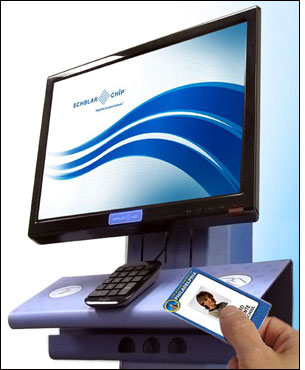ScholarChip‘s School Safety and Operations platform is already enabling students to utilize radio frequency identification cards or fobs to check into classrooms, cafeterias or other sites on their campus. Now, new functionality—which the company released this spring—will allows the school’s staff to employ Near Field Communication (NFC)-enabled smartphones or tablets to capture information from student ID cards. This enables the school to track the students as they ride buses, attend field trips or visit other locations outside classrooms. The mobile version of the system was launched in April, says Maged Atiya, ScholarChip’s founder and CTO. Schools have yet to begin using the Android-based technology, he notes, though several have plans to do so during the coming school year.

Each card or fob, manufactured by ScholarChip, has an embedded RFID tag made with a Mifare chip supplied by NXP Semiconductors. The tag, which is compliant with NFC standards, can be used not only to track student attendance, but also, in some cases, to make purchases within schools, by creating purses for free or subsidized lunches. A student can simply have his or her tag read when buying lunch, and the software on the server (either hosted by ScholarChip or residing on the school’s own database) will manage the payment information, deducting the appropriate amount from that child’s purse.
Until this year, however, the tags could be interrogated only at permanent kiosks containing HID‘s Omnikey RFID readers, such as the Cardman 5321 model. Now, using an Android-based, NFC-enabled phone or tablet, a school could provide some of its employees with the ability to read students’ tags in a more mobile environment, such as on playgrounds, in hallways or on buses. A phone or tablet could also be utilized to identify any child receiving lunch within a classroom or work area, rather than in a cafeteria.
The Android phone or tablet user would simply download a ScholarChip application that would enable him or her to read each tag and have its ID number sent to ScholarChip’s cloud server, where that information could then be linked to details regarding the card holder—specifically, whether that person was a student or a staff member.
One district with plans to begin piloting the mobile solution is the Westbury School District, on Long Island, N.Y., which already uses the ScholarChip system at all of its public schools. A total of 4,600 students currently carry the ScholarChip cards, and 700 employees also utilize them for access control. The schools use Evolis‘ Pebble card printer to generate the ScholarChip cards that it issues to its students and staff.The Westbury School District first adopted the system at some of its schools seven years ago, says Jay Marcucci, the district’s director of technology, communication and information services. Upon entering one of those schools, a studentss taps his or her their cardss at a ScholarChip kiosk containing a built-in RFID reader, thereby providing data for an automatic attendance report indicating which children arrived, and when; that information is then stored on the school’s back-end server. Several years ago, the district also installed ScholarChip the kiosks at some of its cafeterias. By using the system to track attendance within the cafeterias, Marcucci reports, the school district was able to reduce the incidence of students cutting lunch periods by approximately 80 percent.
The district then expanded its use of the solution to employees. Each staff member carries a ScholarChip card, used to control access to various parts of the buildings, such as the district bus office, swimming pool or elevator. High-school students with disabilities can also use their cards to access an elevator.
During the 2011-2012 school year, the district has tested the use of a card reader installed at the doors of four classrooms. At each entrance, the a teacher asks an arriving When entering the room, studentss to tap their his or her their cards against the a door reader as that child enters the room. In that way, an attendance record can be created for that class period, thereby saving the teacher approximately four minutes per class that would otherwise be spent taking a role call.
Next year, the Westbury School District plans to pilot the mobile platform with Android phones that will be used on several buses to capture the ID numbers of students’ cards. In this case, as a student boards a bus, an attendant will use an NFC-enabled phone to read each card’s ID, and that record can either be forwarded to the server in real time, or be stored for uploading into the system later that day, after the vehicle returns to the school. Thus, the district knows automatically if a child has boarded a bus, or has failed to do so as scheduled.
“Our main priority is to know where kids are,” Marcucci states. The technology has not only helped the school district to reduce the incidence of class-cutting, but has also enabled it to contact parents immediately upon determining that a child has not reported to school, rather than waiting for officials to receive teachers’ attendance records.
Meanwhile, educational organizations around the world are also deploying RFID-based systems from a variety of solutions providers (see West Cheshire College Tracks Whereabouts of Students, Staff and RFID Goes to School).



